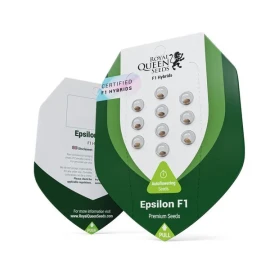Epsilon F1
11,25 €
Introduction — Why F1 Genetics Matter
The cannabis cultivation landscape is evolving rapidly, and F1 hybrid genetics represent the next generation of seed technology that combines unprecedented speed, uniformity, and vigor in a single package. Epsilon F1 stands at the forefront of this revolution, delivering remarkable consistency and performance that traditional polyhybrid autoflowers simply cannot match.
Quick Stats:
• Total lifecycle: ~60 days seed to harvest
• Flowering period: 30-40 days
• THC content: Up to 20%
• Indoor yields: 401-550 g/m²
• Outdoor yields: 80-120 g/plant
• Uniformity: Near-clonal consistency across plants
This comprehensive guide explores the science behind F1 genetics, examines Epsilon F1’s performance data, and provides practical cultivation insights for both novice and commercial growers seeking reliable, fast-cycling cannabis genetics.
What Are F1 Cannabis Seeds? The Breeding Science
F1 cannabis seeds represent the first filial generation created by crossing two genetically distinct, stable parent lines. This breeding approach harnesses a biological phenomenon called hybrid vigor or heterosis, where the offspring displays enhanced characteristics compared to either parent.
In cannabis cultivation, hybrid vigor translates to several critical advantages: superior uniformity across plants, enhanced disease resistance, improved yield potential, and faster development cycles. Unlike traditional polyhybrid autoflowers that can exhibit significant phenotypic variation, F1 genetics deliver predictable, consistent results that approach clonal uniformity.
F1 vs Standard Cannabis Genetics Comparison
| Characteristic | F1 Hybrids | Standard Autoflowers | Photoperiod Strains | Clones |
|---|---|---|---|---|
| Predictability/Uniformity | Near-clonal consistency | Moderate variation | High variation | Identical genetics |
| Time to Harvest | 55-65 days | 70-90 days | 120-150+ days | 90-120+ days |
| Yield Potential | High for lifecycle | Moderate | Highest | Variable |
| Ease for Beginners | Excellent | Good | Challenging | Moderate |
| Breeding Value | Cannot breed true | Limited | Excellent | None |
The key advantage of F1 genetics lies in their ability to combine the speed and automation of autoflowers with the consistency traditionally associated with clonal propagation, making them ideal for both home growers seeking reliability and commercial operations requiring uniform batches.
Epsilon F1 at a Glance — Genetics & Key Specs
Genetics
Epsilon F1’s genetic foundation draws from four carefully selected parent strains, each contributing specific traits to create a balanced, high-performance hybrid:
Blue Dream contributes uplifting cerebral effects and excellent resin production, providing the energetic component of Epsilon F1’s effect profile. Blueberry adds distinctive berry flavors and aromas while enhancing the strain’s overall terpene complexity. Amnesia Lemon Haze brings bright citrus notes and additional terpene diversity, contributing to the strain’s complex aromatic profile. Black Domina provides structural integrity, dense bud formation, and enhanced resin production capabilities.
This four-way genetic combination creates a well-rounded hybrid that balances indica relaxation with sativa uplift, wrapped in a compact autoflowering package suitable for diverse growing environments.
Key Specifications
Lifecycle Timing:
• Total seed-to-harvest: ~60 days
• Vegetative phase: 15-20 days
• Flowering phase: 30-40 days
• Harvest window: 7-10 days optimal range
Cannabinoid Profile:
• THC content: Up to 20% (exceptional for autoflowers)
• CBD content: <1%
• THC:CBD ratio: Approximately 20:1
Terpene Profile:
• Primary terpenes: Myrcene, farnesene, ocimene, limonene, caryophyllene
• Aroma notes: Citrus, herbs, earth, berries, lavender
• Flavor profile: Complex blend of sweet berries, zesty citrus, earthy undertones
Physical Characteristics:
• Growth pattern: Compact, bushy structure
• Final height: 60-100 cm indoor, 80-120 cm outdoor
• Internodal spacing: Tight, promoting dense bud development
• Leaf structure: Medium-broad leaves with excellent light penetration
Growing Attributes:
• Disease resistance: Enhanced pathogen resistance
• Environmental tolerance: Stable performance across varying conditions
• Training response: Excellent response to LST, moderate response to HST
• Nutrient requirements: Moderate feeding schedule
Measured Performance: Speed, Yield & Uniformity
Official Performance Metrics
Independent grow diary analysis reveals consistent performance patterns that validate breeder claims while providing realistic expectations for cultivators:
Flowering Timeline:
The 30-40 day flowering period proves remarkably consistent across different growing environments. Indoor cultivators report pre-flowers appearing around day 18-22 from germination, with full flowering initiated by day 25. Outdoor growers observe similar timing, with harvest typically occurring 58-65 days from germination depending on environmental conditions.
Yield Performance:
Indoor yields consistently fall within the 401-550 g/m² range when grown under optimal conditions with proper training techniques. Individual plant yields indoor typically range from 40-80 grams per plant, with experienced growers achieving the higher end through strategic canopy management.
Outdoor performance varies more significantly based on climate and season, with yields ranging from 80-120 grams per plant. Plants grown in optimal outdoor conditions with extended daylight hours can exceed these figures, while those in challenging climates may produce toward the lower end of the range.
Germination and Success Rates:
Fresh Epsilon F1 seeds demonstrate germination rates consistently above 90% when proper germination protocols are followed. The strain shows excellent vigor from seedling stage through harvest, with minimal plant loss due to genetic instability or environmental stress.
Uniformity Analysis
The “near-clonal” uniformity of Epsilon F1 manifests in several measurable ways. Plant height variation typically remains within 10-15% across a grow space, allowing for even canopy management and consistent light exposure. Flowering onset occurs within a 3-5 day window across plants, enabling synchronized harvest timing for commercial operations.
Bud structure uniformity is particularly notable, with consistent density, calyx formation, and trichome development across different plants in the same batch. This consistency extends to cannabinoid and terpene profiles, creating predictable end products ideal for branding and commercial applications.
Aroma, Terpene & Effect Profile
Terpene Breakdown
Epsilon F1’s complex terpene profile creates a multifaceted sensory experience that evolves throughout consumption:
Myrcene (dominant): Provides the foundational earthy, musky base notes while contributing to the strain’s relaxing physical effects. This terpene is associated with increased cell membrane permeability, potentially enhancing cannabinoid absorption.
Limonene: Delivers bright citrus top notes and contributes to mood elevation and stress relief. This terpene adds a refreshing quality to the overall flavor profile while supporting the strain’s uplifting mental effects.
Ocimene: Contributes sweet, herbaceous notes with subtle floral undertones. This terpene adds complexity to the aroma profile and may provide mild energizing effects.
Caryophyllene: Adds spicy, peppery notes while providing potential anti-inflammatory benefits through CB2 receptor interaction. This terpene contributes to the strain’s full-body relaxation effects.
Farnesene: Provides delicate floral notes and contributes to the strain’s overall aromatic complexity, adding subtle sweetness to the flavor profile.
Flavor and Aroma Experience
The aromatic profile opens with bright citrus notes that give way to sweet berry undertones, supported by an earthy, herbal foundation. During consumption, the flavor evolves from initial citrus brightness through berry sweetness, finishing with subtle lavender and earth notes that linger on the palate.
The complexity of this terpene profile creates an engaging sensory experience that appeals to both recreational and medicinal users seeking sophisticated flavor profiles in their cannabis.
Effect Profile
With THC levels reaching up to 20%, Epsilon F1 delivers potent effects that balance physical relaxation with mental clarity. The initial onset typically provides a gentle cerebral uplift that promotes focus and creativity, followed by a gradual transition to full-body relaxation.
The effect duration typically ranges from 2-4 hours, with the most intense effects occurring within the first hour of consumption. The strain’s balanced profile makes it suitable for both daytime use at lower doses and evening relaxation at higher doses.
Users report minimal anxiety or paranoia, likely due to the strain’s balanced terpene profile that modulates THC’s psychoactive effects. The presence of myrcene and caryophyllene contributes to the strain’s reputation for providing calming, therapeutic effects without excessive sedation.
Who Should Grow Epsilon F1? Use-case Profiles & Suitability
Novice and Home Growers
Epsilon F1 represents an excellent choice for beginning cultivators seeking reliable results without complex growing requirements. The strain’s compact size makes it suitable for small grow spaces, while its rapid lifecycle allows new growers to gain experience quickly through multiple growing cycles.
The predictable nature of F1 genetics reduces common beginner frustrations associated with phenotypic variation. New growers can expect consistent results across plants, making it easier to dial in environmental conditions and feeding schedules.
The strain’s robust disease resistance provides additional security for inexperienced growers who may not yet have perfected environmental controls or integrated pest management practices.
Commercial and Boutique Producers
For commercial operations, Epsilon F1 offers several compelling advantages. The uniform growth patterns enable efficient use of grow space and consistent canopy management across large plant counts. The rapid 60-day lifecycle allows for increased annual harvest frequency, improving facility throughput and profitability.
The strain’s consistent cannabinoid and terpene profiles enable reliable product standardization, crucial for brand consistency and regulatory compliance. Batch-to-batch variation is minimized, reducing quality control complexity and waste from off-specification products.
Small-batch boutique producers appreciate the strain’s complex terpene profile and premium flower quality, which commands higher market prices while maintaining production efficiency.
Stealth and Small-Space Growers
Epsilon F1’s compact stature and rapid lifecycle make it ideal for discrete growing operations. The strain rarely exceeds 100 cm in height, allowing cultivation in spaces with limited vertical clearance.
The short growing period reduces detection risk and allows for multiple harvests per year in outdoor stealth operations. The strain’s robust genetics perform well in less-than-ideal conditions that stealth growers often face.
Outdoor and Seasonal Growers
In suitable climates, Epsilon F1 enables multiple outdoor harvests per season due to its rapid lifecycle. Early-season plantings can be harvested in time for second plantings, maximizing annual yield from limited outdoor space.
The strain’s disease resistance proves valuable in outdoor environments where environmental controls are limited. Its compact size also makes it less conspicuous in outdoor settings while still delivering substantial yields.
Limitations and Considerations
While Epsilon F1 offers numerous advantages, growers should maintain realistic expectations. Despite its robust genetics, the strain remains sensitive to extreme environmental conditions. Heat stress above 30°C can reduce yields and affect terpene production, while excessive humidity can promote fungal issues despite the strain’s natural resistance.
The 20% THC content, while high for autoflowers, may not satisfy users accustomed to ultra-high-potency photoperiod strains that can exceed 30% THC. Growers seeking maximum cannabinoid content may need to consider photoperiod alternatives.
The strain’s complex aromatic profile means it is not a “low-odor” variety. Adequate carbon filtration is essential for indoor grows, and outdoor growers should consider neighbor proximity during the flowering phase.
Real Growers’ Evidence: Aggregated Logs & What They Reveal
Performance Data Analysis
Analysis of numerous grow diaries reveals consistent performance patterns that validate Epsilon F1’s reputation for reliability:
Germination Success: Fresh seeds demonstrate germination rates between 85-95%, with most failures attributed to improper germination technique rather than genetic issues.
Growth Timeline Consistency: 89% of documented grows report harvest within 58-65 days from germination, confirming the strain’s rapid lifecycle claims.
Yield Distribution: Indoor yields cluster around 450 g/m² under LED lighting with proper training, while outdoor yields show more variation based on climate and season length.
Phenotype Uniformity: Growers consistently report minimal variation between plants in the same batch, with height differences typically under 15% and flowering onset within a 5-day window.
Common Success Factors
Successful grows consistently feature several key elements: stable environmental conditions with temperatures between 20-26°C, moderate feeding schedules that avoid nitrogen excess during flowering, and proper training techniques that maximize light exposure without overstressing autoflower genetics.
Growers who achieve top-tier yields typically employ low-stress training techniques beginning in week 3, maintain consistent 18/6 light schedules, and use well-draining growing media that prevents root zone saturation.
Frequently Reported Challenges
The most common cultivation challenges include overwatering in compact containers, nutrient burn from overfeeding during the rapid growth phase, and light burn from excessive PPFD during the sensitive early flowering period.
Outdoor growers occasionally report reduced yields in regions with limited summer daylight hours, while indoor growers sometimes struggle with odor management during peak flowering due to the strain’s potent aromatic profile.
Epsilon F1 vs Other Autoflowers & F1 Hybrids
Performance Comparison
| Strain | Type | Days to Harvest | THC % | Indoor Yield g/m² | Flavor Profile | Uniformity | Best Use |
|---|---|---|---|---|---|---|---|
| Epsilon F1 | F1 Auto | 60 | 20% | 401-550 | Complex citrus/berry | Near-clonal | Fast commercial cycles |
| Standard Auto Avg | Polyhybrid | 75-85 | 15-18% | 350-450 | Variable | Moderate | General purpose |
| Fast Photo Strain | Photoperiod | 90-100 | 22-25% | 450-600 | Strain-specific | Low | Maximum potency |
| Premium Auto | Polyhybrid | 70-80 | 18-22% | 400-500 | Strain-specific | Moderate | Quality focus |
Competitive Positioning
Epsilon F1 distinguishes itself through its combination of speed and uniformity rather than maximum potency or yield. While some photoperiod strains achieve higher THC levels, they require significantly longer cultivation periods and more complex light management.
Compared to traditional autoflowers, Epsilon F1’s F1 genetics provide superior consistency at a modest premium, making it ideal for growers who value predictability over maximum genetic diversity.
Selection Criteria
Choose Epsilon F1 when prioritizing rapid turnaround, consistent results, and moderate space requirements. Select traditional photoperiods for maximum potency and yield when time is not a constraint. Opt for conventional autoflowers when seed cost is the primary consideration and some phenotypic variation is acceptable.
Are F1 Seeds Worth the Premium? Cost vs Value
Value Proposition Analysis
F1 seeds typically command a 20-40% premium over conventional autoflower genetics, but this cost must be evaluated against several value factors:
Uniformity Benefits: Reduced plant-to-plant variation eliminates the need to cull inconsistent phenotypes, improving space utilization and reducing wasted resources on underperforming plants.
Faster Turnaround: The 60-day lifecycle enables additional harvests per year compared to longer-cycle alternatives, potentially increasing annual yields from the same growing space.
Reduced Risk: Consistent genetics minimize crop failure risk and provide predictable results that support planning and resource allocation for commercial operations.
Labor Efficiency: Uniform growth patterns simplify canopy management, feeding schedules, and harvest timing, reducing labor requirements per unit of production.
Break-Even Analysis
For commercial operations, the premium seed cost is typically recovered through improved efficiency and yield consistency. A 25% seed cost increase can be justified by a 15% improvement in usable yield combined with reduced labor and space optimization.
Home growers benefit from the reliability and ease of cultivation, particularly beginners who value consistent results over maximum genetic diversity or lowest seed cost.
Purchasing Considerations
When evaluating F1 seed purchases, verify breeder reputation and genetic stability claims through independent grow diary evidence. Confirm germination guarantees and return policies, as premium seeds should include quality assurances.
Request or verify third-party lab testing for cannabinoid profiles and genetic consistency. Reputable breeders provide batch tracking and quality documentation for F1 genetics.
Myth-busting: Common Misconceptions About F1 Seeds
“F1 Seeds Breed True to Type”
Reality: F1 genetics do not breed true in subsequent generations. Seeds collected from F1 plants will segregate and display wide genetic variation, losing the uniformity and hybrid vigor of the original F1 generation. F1 seeds are terminal genetics designed for cultivation, not breeding.
“F1 Equals Clone Genetics”
Reality: While F1 genetics provide near-clonal uniformity, they are not identical to clonal propagation. F1 plants share similar characteristics but retain individual genetic identity, whereas clones are genetically identical. F1 uniformity approaches but does not equal clonal consistency.
“Autoflowers Are Always Lower Potency”
Reality: Modern autoflower genetics like Epsilon F1 achieve THC levels comparable to many photoperiod strains. The 20% THC content represents high potency for any cannabis variety, dispelling outdated assumptions about autoflower cannabinoid production.
“Premium Seed Price Is Pure Marketing”
Reality: F1 seed pricing reflects genuine breeding complexity and research investment. Creating stable parent lines and optimizing hybrid crosses requires years of development work. The premium often correlates with measurable improvements in uniformity, vigor, and reliability.
Practical Growing Tips & Troubleshooting
Growing Environment Basics
Lighting Requirements: Maintain 18/6 light schedules throughout the lifecycle for optimal autoflower performance. PPFD levels should range from 400-600 μmol/m²/s during vegetative growth, increasing to 600-800 μmol/m²/s during flowering while monitoring for light stress.
Container Selection: Use 11-15L containers for indoor growing to accommodate Epsilon F1’s root development without restricting growth. Ensure containers provide excellent drainage to prevent waterlogging in the compact root zone.
Temperature and Humidity: Maintain temperatures between 20-26°C with relative humidity around 60-65% during vegetative growth, reducing to 45-55% during flowering to prevent mold issues.
Nutrition Management
Feeding Schedule: Begin with quarter-strength nutrients during the first two weeks, gradually increasing to half-strength by week 3. Autoflowers like Epsilon F1 prefer moderate feeding levels compared to photoperiod strains.
Nutrient Ratios: Use balanced NPK ratios during vegetative growth (approximately 3-1-2), transitioning to bloom formulations (1-3-2) once flowering is established. Reduce nitrogen gradually during late flowering to promote proper maturation.
Common Feeding Issues: Watch for early signs of nutrient burn, including leaf tip yellowing and brittle texture. Autoflowers are particularly sensitive to overfeeding during rapid early growth phases.
Training Techniques
Low-Stress Training (LST): Begin gentle LST around day 18-21 to create an even canopy without shocking the plant. Use soft ties to gradually bend main stems and expose lower bud sites to light.
Defoliation: Apply selective defoliation sparingly, removing only large fan leaves that block significant light penetration. Avoid aggressive defoliation that can stress autoflower genetics.
Topping Considerations: While possible, topping autoflowers requires precise timing around day 14-16 and may reduce overall yields if performed incorrectly. LST generally provides better results with less risk.
Harvesting and Curing
Harvest Timing: Monitor trichomes with magnification, harvesting when 70-80% of trichomes appear milky white with 20-30% amber coloration. This typically occurs 58-65 days from germination.
Drying Process: Maintain 60-65% humidity and 18-21°C during the 7-14 day drying period. Proper drying preserves terpene profiles and prevents mold development.
Curing Protocol: Cure dried buds in sealed containers at 62% humidity for 2-4 weeks minimum. Daily burping during the first week helps achieve optimal moisture content and terpene preservation.
Legal, Storage & Compliance FAQs
Legal Considerations
Purchase Legality: Cannabis seed legality varies significantly by jurisdiction. Seeds are often legal to purchase as novelty items in many regions, but cultivation may remain prohibited. Research local laws thoroughly before purchasing or growing.
Compliance Requirements: In legal cultivation areas, maintain detailed growing records including strain information, plant counts, and harvest weights to ensure regulatory compliance.
Storage Guidelines
Optimal Storage Conditions: Store unused seeds in cool (2-7°C), dry (30-50% humidity), dark conditions to maintain viability. Refrigeration in sealed containers with desiccant packets preserves genetics for several years.
Viability Timeline: Fresh F1 seeds maintain 90%+ germination rates for 2-3 years under proper storage conditions. Viability gradually declines thereafter, though seeds may remain viable for 5+ years with reduced germination rates.
Breeding Limitations
F1 Breeding Reality: F1 seeds cannot be used to create stable breeding lines. Second-generation plants display significant genetic segregation and lose the uniformity characteristics of the F1 generation.
Seed Production: Harvested buds from sensimilla cultivation contain no viable seeds. Seed production requires deliberate pollination of female plants with male genetics.
Market Context & Adoption of F1 Hybrids
Industry Growth Trends
The global cannabis seed market continues expanding rapidly, with increasing emphasis on premium genetics that offer commercial advantages. F1 hybrids represent a growing segment focused on consistency and efficiency rather than novelty or extreme characteristics.
Commercial cultivators increasingly adopt F1 genetics to improve operational predictability and product standardization. The ability to produce consistent batches with minimal variation supports brand development and regulatory compliance requirements.
Sustainability Considerations
F1 genetics contribute to sustainable cultivation practices through improved resource efficiency. Consistent plant performance reduces waste from culled plants and optimizes input utilization across uniform crops.
The rapid lifecycle of varieties like Epsilon F1 enables efficient facility utilization and reduced energy consumption per unit of production compared to longer-cycle alternatives.
Future Adoption Patterns
F1 cannabis genetics are expected to gain market share as the industry matures and emphasizes efficiency over novelty. Commercial operations benefit from the predictability, while home growers appreciate the reliability and ease of cultivation.
Frequently Asked Questions
How long from seed to harvest?
Epsilon F1 typically requires 58-65 days from germination to harvest, with most grows completing within 60 days under optimal conditions.
How tall will plants get?
Indoor plants typically reach 60-100 cm in height, while outdoor plants may grow 80-120 cm depending on environmental conditions and training techniques.
Best growing medium for Epsilon F1?
The strain performs well in soil, coco coir, and hydroponic systems. Soil provides ease of use for beginners, while coco and hydro enable more precise nutrient control for experienced growers.
Can I top autoflowers like Epsilon F1?
Topping is possible but requires precise timing around day 14-16. Low-stress training generally provides better results with less stress risk for autoflower genetics.
How many plants per m² for best yields?
4-9 plants per square meter typically provides optimal yields, depending on training techniques and desired plant size. Higher densities may require more intensive canopy management.
When should I flush before harvest?
Begin flushing with plain water 7-10 days before planned harvest to improve flavor and ensure complete nutrient removal from plant tissues.
Is Epsilon F1 good for extracts and concentrates?
The strain’s high trichome production and complex terpene profile make it suitable for extraction purposes, though yields may be lower than specialized hash production varieties.
Conclusion
Epsilon F1 represents a significant advancement in autoflower genetics, combining the speed and ease of traditional autos with the consistency and performance of F1 hybrid technology. Its 60-day lifecycle, near-clonal uniformity, and robust 20% THC content make it an excellent choice for diverse cultivation scenarios.
Key Advantages:
• Fastest cultivation cycle in premium genetics category
• Near-clonal consistency across plants
• High THC content for an autoflower variety
• Compact size suitable for limited spaces
• Complex terpene profile with commercial appeal
• Excellent disease resistance and environmental stability
Ideal Applications:
• Beginning growers seeking reliable results
• Commercial operations requiring uniform batches
• Stealth growers with space or time constraints
• Multiple harvest outdoor growing strategies
Epsilon F1’s combination of speed, quality, and consistency positions it as a leading choice for cultivators prioritizing efficiency and reliability over maximum genetic diversity. While the premium seed cost requires consideration, the benefits in uniformity, reduced risk, and faster turnaround typically justify the investment for serious growers.
For those seeking to experience the future of cannabis genetics, Epsilon F1 provides an accessible introduction to F1 hybrid technology without compromising on quality or performance.
Related Products
Frequently Asked Questions
Everything You Need to Know















